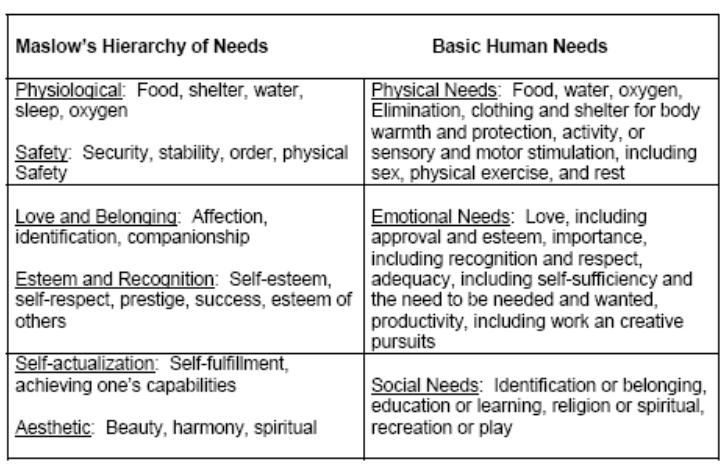 This is the Archived Desktop Edition. You should be transferred to the Newest Edition for Desktop and Mobile within 2 seconds. |
||||
Lesson 1: Patient Relations |
||||
|
SECTION I. BASIC HUMAN NEEDS AND PRINCIPLES OF HEALTH 1-6. CATEGORIES OF BASIC HUMAN NEEDS Physical Needs. These are closely related to body functions and are sometimes referred to as primary or physiological drives. Physical needs include:
Emotional Needs. Emotional needs are closely interwoven with physical needs and are met in interaction with significant others. They include:
Social Needs. Social needs grow out of the culture and society of which one is a member. They include:
1-7. MASLOW'S HIERARCHY OF NEEDS Psychologist Abraham Maslow defined basic human needs as a hierarchy, a progression from simple physical needs to more complex emotional needs (see figure 1-2). Types of Needs.
Relationship Between Levels of Needs.
Figure 1-2. Maslow's hierarchy of needs. 1-8. COMPARISON OF BASIC HUMAN NEEDS AND MASLOW'S HIERARCHY OF NEEDS The categories of Maslow's hierarchy are closely related to the basic human needs discussed in paragraph 1-6. Table 1-1 contains a comparison. Maslow’s Hierarchy of Needs Basic Human Needs
Table 1-1. Comparison of basic human needs and Maslow’s hierarchy of needs.
1-9. CLOSING Remember that human needs are not constant; they are fluid and changing with first one, then another, taking priority. What may start as a basic need for food can take on social and personal significance. Your care plan as well as your patience are aimed toward the satisfaction of the patient's needs. He has common needs because he is a person; he has individual needs because he is unique; he has special needs because he is sick. The Practical Nurse supplies the help that is required to meet the patient's needs during the stressful periods of hospitalization and recuperation.
The Brookside Associates Medical Education Division is dedicated to the development and dissemination of medical information that may be useful to medical professionals and those in training to become medical professionals. This website is privately-held and not connected to any governmental agency. The views expressed here are those of the authors, and unless otherwise noted, do not necessarily reflect the views of the Brookside Associates, Ltd., any governmental or private organizations. All writings, discussions, and publications on this website are unclassified. © 2007 Medical Education Division, Brookside Associates, Ltd. All rights reserved |
|
|||
|
|
||||

